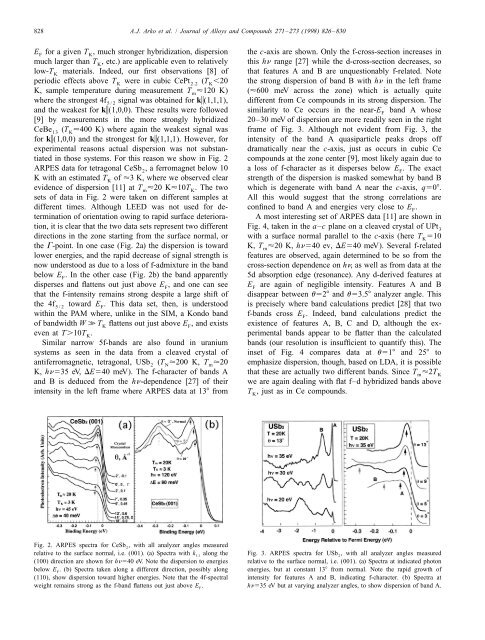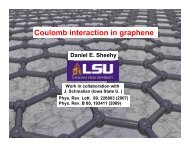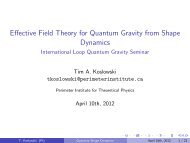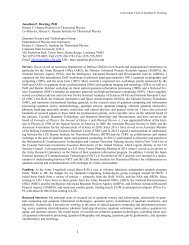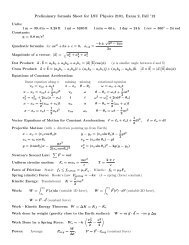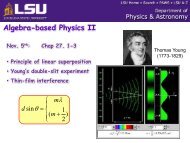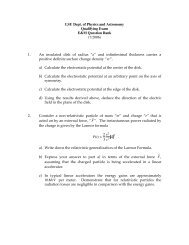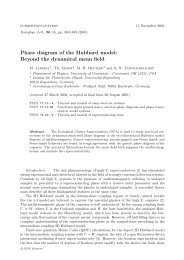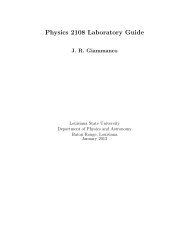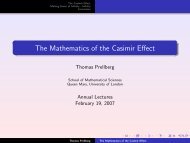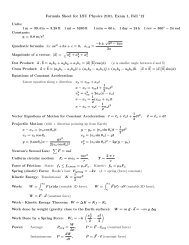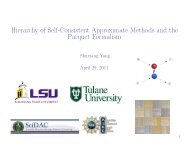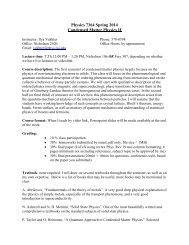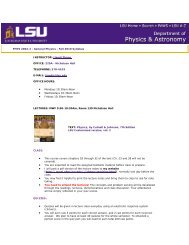ARPES in strongly correlated 4f and 5f systems: Comparison to the ...
ARPES in strongly correlated 4f and 5f systems: Comparison to the ...
ARPES in strongly correlated 4f and 5f systems: Comparison to the ...
Create successful ePaper yourself
Turn your PDF publications into a flip-book with our unique Google optimized e-Paper software.
828 A.J. Arko et al. / Journal of Alloys <strong>and</strong> Compounds 271 –273 (1998) 826 –830EFfor a given TK, much stronger hybridization, dispersion <strong>the</strong> c-axis are shown. Only <strong>the</strong> f-cross-section <strong>in</strong>creases <strong>in</strong>much larger than T , etc.) are applicable even <strong>to</strong> relatively this hn range [27] while <strong>the</strong> d-cross-section decreases, soKlow-T materials. Indeed, our first observations [8] of that features A <strong>and</strong> B are unquestionably f-related. NoteKperiodic effects above T were <strong>in</strong> cubic CePt (T ,20 <strong>the</strong> strong dispersion of b<strong>and</strong> B with hn <strong>in</strong> <strong>the</strong> left frameK 2.2 KK, sample temperature dur<strong>in</strong>g measurement T ¯120 K) (¯600 meV across <strong>the</strong> zone) which is actually quitemwhere <strong>the</strong> strongest <strong>4f</strong> signal was obta<strong>in</strong>ed for ki(1,1,1), different from Ce compounds <strong>in</strong> its strong dispersion. The5/2<strong>and</strong> <strong>the</strong> weakest for ki(1,0,0). These results were followed similarity <strong>to</strong> Ce occurs <strong>in</strong> <strong>the</strong> near-E b<strong>and</strong> A whoseF[9] by measurements <strong>in</strong> <strong>the</strong> more <strong>strongly</strong> hybridized 20–30 meV of dispersion are more readily seen <strong>in</strong> <strong>the</strong> rightCeBe13(TK¯400 K) where aga<strong>in</strong> <strong>the</strong> weakest signal was frame of Fig. 3. Although not evident from Fig. 3, <strong>the</strong>for ki(1,0,0) <strong>and</strong> <strong>the</strong> strongest for ki(1,1,1). However, for <strong>in</strong>tensity of <strong>the</strong> b<strong>and</strong> A quasiparticle peaks drops offexperimental reasons actual dispersion was not substan- dramatically near <strong>the</strong> c-axis, just as occurs <strong>in</strong> cubic Cetiated <strong>in</strong> those <strong>systems</strong>. For this reason we show <strong>in</strong> Fig. 2 compounds at <strong>the</strong> zone center [9], most likely aga<strong>in</strong> due <strong>to</strong><strong>ARPES</strong> data for tetragonal CeSb2, a ferromagnet below 10 a loss of f-character as it disperses below EF. The exactK with an estimated TKof ¯3 K, where we observed clear strength of <strong>the</strong> dispersion is masked somewhat by b<strong>and</strong> Bevidence of dispersion [11] at Tm¯20 K¯10TK. The two which is degenerate with b<strong>and</strong> A near <strong>the</strong> c-axis, q508.sets of data <strong>in</strong> Fig. 2 were taken on different samples at All this would suggest that <strong>the</strong> strong correlations aredifferent times. Although LEED was not used for de- conf<strong>in</strong>ed <strong>to</strong> b<strong>and</strong> A <strong>and</strong> energies very close <strong>to</strong> EF.term<strong>in</strong>ation of orientation ow<strong>in</strong>g <strong>to</strong> rapid surface deteriora- A most <strong>in</strong>terest<strong>in</strong>g set of <strong>ARPES</strong> data [11] are shown <strong>in</strong>tion, it is clear that <strong>the</strong> two data sets represent two different Fig. 4, taken <strong>in</strong> <strong>the</strong> a–c plane on a cleaved crystal of UPt 3directions <strong>in</strong> <strong>the</strong> zone start<strong>in</strong>g from <strong>the</strong> surface normal, or with a surface normal parallel <strong>to</strong> <strong>the</strong> c-axis (here TK510<strong>the</strong> G-po<strong>in</strong>t. In one case (Fig. 2a) <strong>the</strong> dispersion is <strong>to</strong>ward K, Tm¯20 K, hn540 ev, DE540 meV). Several f-relatedlower energies, <strong>and</strong> <strong>the</strong> rapid decrease of signal strength is features are observed, aga<strong>in</strong> determ<strong>in</strong>ed <strong>to</strong> be so from <strong>the</strong>now unders<strong>to</strong>od as due <strong>to</strong> a loss of f-admixture <strong>in</strong> <strong>the</strong> b<strong>and</strong> cross-section dependence on hn, as well as from data at <strong>the</strong>below EF. In <strong>the</strong> o<strong>the</strong>r case (Fig. 2b) <strong>the</strong> b<strong>and</strong> apparently 5d absorption edge (resonance). Any d-derived features atdisperses <strong>and</strong> flattens out just above EF, <strong>and</strong> one can see EFare aga<strong>in</strong> of negligible <strong>in</strong>tensity. Features A <strong>and</strong> Bthat <strong>the</strong> f-<strong>in</strong>tensity rema<strong>in</strong>s strong despite a large shift of disappear between u528 <strong>and</strong> u53.58 analyzer angle. This<strong>the</strong> <strong>4f</strong>5/2 <strong>to</strong>ward EF. This data set, <strong>the</strong>n, is unders<strong>to</strong>od is precisely where b<strong>and</strong> calculations predict [28] that twowith<strong>in</strong> <strong>the</strong> PAM where, unlike <strong>in</strong> <strong>the</strong> SIM, a Kondo b<strong>and</strong> f-b<strong>and</strong>s cross EF. Indeed, b<strong>and</strong> calculations predict <strong>the</strong>of b<strong>and</strong>width W4TKflattens out just above EF, <strong>and</strong> exists existence of features A, B, C <strong>and</strong> D, although <strong>the</strong> exevenat T.10T .perimental b<strong>and</strong>s appear <strong>to</strong> be flatter than <strong>the</strong> calculatedKSimilar narrow <strong>5f</strong>-b<strong>and</strong>s are also found <strong>in</strong> uranium b<strong>and</strong>s (our resolution is <strong>in</strong>sufficient <strong>to</strong> quantify this). The<strong>systems</strong> as seen <strong>in</strong> <strong>the</strong> data from a cleaved crystal of <strong>in</strong>set of Fig. 4 compares data at u518 <strong>and</strong> 258 <strong>to</strong>antiferromagnetic, tetragonal, USb2(TN¯200 K, Tm¯20 emphasize dispersion, though, based on LDA, it is possibleK, hn535 eV, DE540 meV). The f-character of b<strong>and</strong>s A that <strong>the</strong>se are actually two different b<strong>and</strong>s. S<strong>in</strong>ce Tm¯2TK<strong>and</strong> B is deduced from <strong>the</strong> hn-dependence [27] of <strong>the</strong>ir we are aga<strong>in</strong> deal<strong>in</strong>g with flat f–d hybridized b<strong>and</strong>s above<strong>in</strong>tensity <strong>in</strong> <strong>the</strong> left frame where <strong>ARPES</strong> data at 138 fromT , just as <strong>in</strong> Ce compounds.KFig. 2. <strong>ARPES</strong> spectra for CeSb2, with all analyzer angles measuredrelative <strong>to</strong> <strong>the</strong> surface normal, i.e. (001). (a) Spectra with k11 along <strong>the</strong> Fig. 3. <strong>ARPES</strong> spectra for USb2, with all analyzer angles measured(100) direction are shown for hn540 eV. Note <strong>the</strong> dispersion <strong>to</strong> energies relative <strong>to</strong> <strong>the</strong> surface normal, i.e. (001). (a) Spectra at <strong>in</strong>dicated pho<strong>to</strong>nbelow EF. (b) Spectra taken along a different direction, possibly along energies, but at constant 138 from normal. Note <strong>the</strong> rapid growth of(110), show dispersion <strong>to</strong>ward higher energies. Note that <strong>the</strong> <strong>4f</strong>-spectral <strong>in</strong>tensity for features A <strong>and</strong> B, <strong>in</strong>dicat<strong>in</strong>g f-character. (b) Spectra atweight rema<strong>in</strong>s strong as <strong>the</strong> f-b<strong>and</strong> flattens out just above EF.hn535 eV but at vary<strong>in</strong>g analyzer angles, <strong>to</strong> show dispersion of b<strong>and</strong> A.


